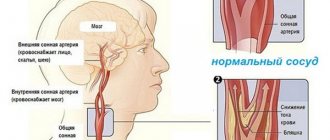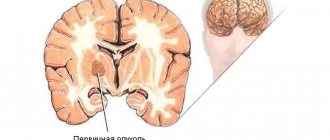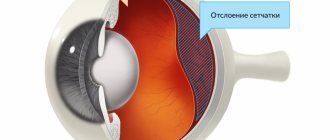Anatomy of the frontal region, what can hurt
Pain in the forehead above the bridge of the nose can be self-diagnosed. To do this, it is necessary to consider its most likely causes.
Nasociliary nerve
This is the name given to one of the parts of the trigeminal nerve, coming from the auricle above the eyebrow and rising to the middle of the forehead. Neuralgia of the nasociliary nerve, which occurs when it is compressed by adjacent tissues, is manifested by pain of moderate intensity, affecting the forehead and sinuses. They usually get worse at night, causing insomnia.
Pain may also be accompanied by other symptoms:
- a feeling of pulsation, pressure and fullness, localized in the middle of the forehead and in the bridge of the nose;
- redness of the eyes and watery eyes;
- swelling of the nose, the appearance of discharge.
Other types of neuralgia that can cause similar symptoms include neuralgia of the superior branch of the trigeminal nerve, and ganglionitis, an inflammation of the ciliary nerve ganglion located in the back of the orbit.
bridge of the nose
With her injuries, the following may appear:
- swelling of soft tissues;
- cartilage damage;
- fracture of the nasal septum.
The pain in these cases affects not only the bridge of the nose itself, but also the forehead area above it.
The following symptoms are also characteristic of injuries to the bridge of the nose:
- extensive hematoma spreading to the eyes, forehead, nose;
- swelling of the upper and central area of the face;
- acute pain at the site of impact, which intensifies with any touch to the bridge of the nose;
- difficulty in nasal breathing.
Paranasal sinuses
These are the cavities of the skull, located on the front of it and normally filled with air, which are connected by narrow channels to the nasal passages. Through these channels, mucus and pathogens enter the sinuses, becoming the cause of a group of inflammatory diseases collectively called sinusitis.
Common symptoms of sinusitis of any kind are:
- pain localized in the frontal part of the head and intensifying when it is turned or tilted;
- purulent nasal discharge;
- temperature increase.
In addition, depending on the location of the source of infection, additional symptoms may appear:
| Disease | Localization of pain |
| Sinusitis (inflammation of the maxillary sinuses) | Eye and cheek area |
| Frontitis (inflammation of the frontal sinuses) | Brow ridges |
| Ethmoiditis (inflammation of the ethmoid labyrinth) | The area between the eyebrows and the bridge of the nose. Since the nerve endings responsible for the perception of odors pass here, with ethmoiditis the sense of smell is often reduced. |
| Sphenoiditis (inflammation of the sphenoid sinuses) | Occipital and parietal region. Their appearance is accompanied by severe swelling of the nasal mucosa and runny nose. |
Simultaneous damage to the sinuses of several types is also possible. In this case, the possible symptoms include a feeling of fullness and pressure on the bridge of the nose.
Diagnostic features
It is best to treat even a common cold under the supervision of a doctor. Regardless of whether there is pressure in the nose or pain, it is difficult to make a correct diagnosis at home. Rhinitis can be treated by a therapist; if complications develop (sinusitis, ethmoiditis), you must contact an otolaryngologist.
The ENT performs a thorough examination of the patient using special instruments. Nowadays, otolaryngologists even have a special chair installed in their offices, which makes it more convenient to examine the patient. Usually, only the patient’s complaints are not enough; the full picture of the disease is revealed after the person undergoes tests. Your doctor may recommend additional testing:
- Take a general blood and urine test.
- Take a nasal swab to determine the flora (helps to exclude staphylococcal, streptococcal infections).
- Take an X-ray of the nose.
- Take a test with a solution of Dicaine and Adrenaline to confirm ganglionitis.
To determine the correct treatment tactics, consultation with other specialists – a neurologist, dentist, surgeon – may be required.
Common causes of pain in the forehead above the bridge of the nose
Pain in the forehead above the bridge of the nose is a direct consequence of damage to structures located in the immediate vicinity. However, there are a number of diseases and conditions that develop for other reasons for which headache is one of the symptoms.
Poisoning
Headache is a direct consequence of intoxication - disturbances in the functioning of internal organs.
They arise depending on the etiology:
- a drop in hemoglobin levels, a decrease in insulin production - in case of food poisoning;
- release of a huge amount of toxins into the bloodstream due to a bacterial infection;
- the formation of clots that clog the capillaries of the brain vessels - in case of alcohol poisoning;
- massive destruction of red blood cells and, as a result, oxygen starvation of the brain - due to intoxication with drugs or inhalation of toxic gaseous mixtures.
All these reasons can cause not only severe headaches, but also other symptoms that can be used to diagnose poisoning:
- diarrhea;
- bloating, colic;
- nausea, vomiting;
- disappearance or weakening of appetite;
- general malaise.
Pathology of the cardiovascular system
Diseases such as atherosclerosis, vegetative-vascular dystonia, hypertension, ischemia, and stroke cause pain of varying intensity. They are felt most strongly in the back of the head and temples, but are often accompanied by pain in the forehead.
The root cause of cephalalgia may be:
- excessive stretching of the walls of blood vessels, causing throbbing pain;
- a significant decrease in blood pressure, at which the pain becomes pressing, bursting, dull;
- stagnation of venous blood, which is diagnosed by paroxysmal dull pain, which, reaching its peak, is accompanied by dizziness.
Additional symptoms indicating pathologies of the cardiovascular system include the appearance of “spots” before the eyes, sometimes:
- nausea and vomiting;
- dyspnea;
- heart rhythm disturbances;
- discomfort in the chest area;
- general deterioration of health.
Traumatic brain injury
The so-called post-traumatic headache can appear a few days after a traumatic brain injury and not disappear for several years.
Cephalgia caused by this cause is characterized by:
- periodicity, change in intensity depending on the general condition. Attacks become stronger with overwork, strong emotions, fatigue, and high physical exertion;
- always the same location, depending on the lesion. It may hurt above the right or left eyebrow, above the bridge of the nose, closer to the temples;
- same nature of pain. It is most often described as acute, pulsating, accompanied by intolerance to bright light, loud sounds, strong odors, or dull, uniform, like a hoop squeezing the head.
The causes of such pain are quite dangerous, it can be:
- intracranial hematoma;
- hemorrhage into the cavity located between the soft and arachnoid membranes of the brain (subarachnoid space);
- brain contusion, accompanied by swelling of its membranes.
Exposure to high or low temperatures
Pain in the forehead above the bridge of the nose can occur when the ambient temperature is outside the comfortable range.
There are:
| Pain at low temperatures | Pain at high temperatures |
Their causes have not yet been studied, but it is known that in people suffering from this pathology they occur when:
| They usually occur against the background of dehydration, and, as a result, deterioration of blood supply to the brain. Another reason may be excessive stress on the heart or high blood pressure. In this case, other symptoms are associated with cephalgia:
|
Cerebrospinal fluid puncture
Post-puncture headache (PPPH) in the frontal region of the head is one of the most common side effects that can occur after a lumbar puncture.
The main cause of PPH is the hole that remains open after the puncture, through which cerebrospinal fluid continues to flow, acting as a shock absorber for the brain, maintaining it in the correct position. If the loss of fluid is greater than the body can synthesize, the brain “sags,” stretching nearby tissues, nerve fibers, and blood vessels, which becomes the cause of headaches.
PPBG can be recognized by the inherent ability of pain of this type to intensify as soon as the body assumes a vertical position and weaken in a lying position.
Additional symptoms include:
- feeling of tension in the neck;
- stiffness of movements;
- nausea, vomiting (sometimes).
Usually, after 2-3 days these symptoms disappear, but if this does not happen, a so-called “blood filling” is installed. A small amount of blood is injected into the puncture and closes the hole.
Metabolic disorder
These are sequences of biochemical reactions that ensure the vital functions of the body. If some of them fail, this immediately affects the general well-being and becomes the cause of headaches that may arise due to metabolic processes being disrupted:
- sharp fluctuations in blood pressure;
- oxygen starvation of the brain due to vegetative-vascular disorders;
- hormonal imbalance.
In case of metabolic disorders, headache is only one of the symptoms; it is accompanied by others:
- changes in the appearance of skin, hair, nails;
- insomnia;
- joint pain;
- a sharp change in weight indicators.
Endocrine diseases
With endocrine diseases, in particular problems with the thyroid gland, headaches associated with a lack or excess of hormones produced by it (thyroxine, triiodothyronine) are a common occurrence.
They can be recognized by the following characteristic features:
- sudden appearance;
- rapid increase in intensity;
- the pain is not relieved by conventional medications: antispasmodics, pain relievers;
- the attack lasts several days;
- stops abruptly.
Associated symptoms include:
- heightened sense of smell;
- irritability;
- sweating;
- skin greasiness;
- constipation;
- weakening of memory;
- weakness;
- deterioration of health.
Diseases affecting the adrenal glands, parathyroid glands, pancreas and other organs responsible for the production of hormones can also cause similar causes and symptoms, including headaches.
Blood diseases
Blood diseases include pathologies associated with:
- changes in its quantitative and qualitative composition;
- violations of the structure of its structural elements.
This leads to a sharp decrease in its ability to perform its main function - to supply organs, including the brain, with oxygen.
In addition, a possible increase in blood viscosity in these diseases, loss of elasticity in red blood cells and the appearance of a tendency for platelets to stick together leads to stagnation of venous blood in intracranial structures and excessive pressure on them. Hypoxia of brain tissue, combined with congestion, becomes the main cause of cephalalgia, manifested by dull pain, the intensity of which can vary over a wide range.
Additional symptoms will be:
- phantom tinnitus;
- feeling of heaviness in the forehead and back of the head;
- drowsiness.
Differentiation of pain in the forehead above the bridge of the nose
Headache of low to moderate intensity, not accompanied by other unpleasant symptoms – result:
- overwork;
- stress;
- exposure to too much light;
- loud noise.
This is considered a normal reaction of the body and is easily eliminated by taking appropriate medications. Pain in combination with other symptoms may indicate pathology.
Why does my forehead and eyes hurt?
The appearance of pain in the eyes and in the frontal part of the head during prolonged work with small objects, reading in poor lighting, or after sitting for a long time at the computer is explained by fatigue of the eye muscles. As a rule, after a short rest, these symptoms disappear without a trace.
If such a combination of symptoms is a regular and frequent occurrence and appears without any apparent reason, this may indicate the development of a dangerous eye disease - angle-closure glaucoma. Cephalgia develops due to increased intraocular pressure, is localized in the forehead, usually on one side, and has moderate intensity.
Other symptoms of glaucoma:
- vagueness;
- blurred image;
- feeling of painful pressure on the eyes;
- nausea (sometimes).
Also, pain in the eyes and forehead can occur due to:
- migraine;
- sinusitis;
- hypertension;
- cervical osteochondrosis.
Why does my forehead hurt and there is a feeling of pressure?
A feeling of pressure and fullness in the bridge of the nose, combined with a headache above it, is a clear symptom of sinusitis, in which not only the frontal sinuses become inflamed (frontal sinusitis), but also the ethmoidal labyrinth (ethmoiditis). The pain may spread to the inner corners of the eyes and the middle of the nose.
Why does my forehead and temples hurt?
Pain in the forehead above the bridge of the nose and in the temples may indicate a violation of blood flow due to compression of the vessels of the neck, muscle clamps, pinched nerve endings, and displacement of the intervertebral discs. The pain may be accompanied by a feeling of numbness and pressure on the frontal part of the head.
Diseases with similar symptoms include:
- cervical osteochondrosis;
- cervical radiculitis;
- scoliosis, kyphosis;
- hernias and protrusions of intervertebral discs.
Also, pain in the temples spreading to the forehead is characteristic of:
- hypertension;
- migraine;
- neuritis and neuralgia of the facial nerve;
- brain encephalopathy.
Why does my forehead hurt and feel nauseous?
The root cause of headaches accompanied by nausea is insufficient blood supply to the brain, which is possible with the following diseases:
- cerebrovascular disease, in which nausea and pain are direct consequences of narrowing of the blood vessels in the brain;
- meningitis;
- traumatic brain injury;
- blood diseases that change its viscosity (thrombosis, thrombocypenia).
Why does my forehead and back of my head hurt?
The main function of the meninges is to protect the brain substance from mechanical damage. When they are exposed to a fungal, bacterial, or viral infection, meningitis develops - a serious infectious disease.
It manifests itself as a continuous headache and:
- high fever;
- hearing and vision problems;
- rigidity (weakness) of the neck muscles;
- nausea, vomiting;
- convulsions;
- mental disorders.
Encephalitis, which affects brain tissue, has similar symptoms.
Why does my forehead and nose hurt?
Pain in the forehead that extends to the bridge of the nose is characteristic of the following diseases:
- neuralgia of the ophthalmic branch of the trigeminal nerve. In addition to pain, the following symptoms are possible: spasms of the facial muscles, decreased or increased sensitivity of the facial skin, slight fever;
- injuries to the bridge of the nose. In this case, there are external traces: bruises, violations of the integrity of the skin;
- inflammation of the paranasal sinuses (sinusitis). With it, pain in the bridge of the nose intensifies when trying to turn the head or touch the bridge of the nose, accompanied by discomfort in the eye area;
- allergic reactions that cause swelling of the nasal mucosa.
Why does my forehead hurt when I have a runny nose?
Cephalgia, localized in the forehead with a runny nose, is a common occurrence.
It occurs for several interrelated reasons:
- an increase in temperature leads to dilation of blood vessels and an increase in the volume of intracranial fluid, which begins to put pressure on brain tissue, causing pain;
- swelling of the nasal mucosa makes it difficult for oxygen to enter the lungs, which causes brain hypoxia to develop;
- with a runny nose of a viral or bacterial nature, the cause of pain is intoxication of the body.
Also, headaches can be triggered by frequent and excessively intense nose blowing, which strains the blood vessels and muscles of the face.
Pain when bending forward
The most common cause of cephalgia that occurs during certain head movements is a spasm of the muscles located in the neck and shoulders that provide these movements.
Spasm can occur for a number of reasons:
- staying the body in the same position for a long time;
- lack of physical activity;
- uncomfortable posture during sleep;
- avitaminosis;
- weather dependence;
- stress.
When is a doctor needed?
People often put off going to the doctor until later: they put vasoconstrictor drops into the nose, relieve pain with analgesics, but if the pain in the bridge of the nose and forehead does not go away and only gets worse, they should seek medical help. Doctor's help is also necessary if the following symptoms occur:
- An increase in body temperature to 38.5 degrees for a long period of time - more than three days.
- Continuous headaches.
- Feeling of heaviness in the head.
- Inability to bend over due to pain.
- The appearance of a rash on the body.
- The pain is so intense that the patient cannot sleep.
- Discharge of purulent contents from the nose.
- Severe nausea, vomiting, dizziness for several days.
Even one of the listed symptoms should alert you; if a combination of symptoms occurs, the doctor may suspect the development of meningitis in the patient.
Diagnosis of the causes of pain in the frontal part of the head
If you experience regular persistent pain in the forehead area, accompanied by other symptoms, you should consult a doctor to find out the causes of cephalgia. The first stage of diagnosis will be an oral conversation, during which you will have to answer questions about the nature of the pain, the frequency of attacks, and accompanying complaints.
Based on these data, the following types of examination can be prescribed:
- electroencephalography – if there is a suspicion of vascular disease, the presence of a tumor or hematoma;
- X-ray – to detect increased intracranial pressure, sinusitis or head injuries;
- MRI – will confirm or deny the presence of a tumor, circulatory problems, inflammation of the sinuses;
- CT scan – is prescribed if a stroke is suspected to examine the tissues and blood vessels of the brain;
- electromyography - will determine whether there are neuralgic causes of cephalgia;
- Ultrasound – will be required to identify an aneurysm, the presence of atherosclerotic plaques, and other vascular pathologies;
- laboratory tests of biomaterial, if the suspected cause of pain is an inflammatory process, infectious diseases, or metabolic disorders.
What to do if you have pain above the bridge of your nose
To treat primary cephalgia, as well as to alleviate the patient’s condition with secondary cephalgia, both medications and folk remedies can be used.
Drugs
The most commonly prescribed drugs are:
- analgesics that relieve pain and at the same time provide an anti-inflammatory and antipyretic effect. Analgesics include Analgin, Paracetamol, Panadol;
- antispasmodics. Drugs of this type are divided into myotropic, which have a relaxing effect on the muscles and walls of blood vessels (Papaverine, Dibazol), and neurotropic, which block the entry of pain impulses into the brain (Buscopan, Aprofen);
- vasoconstrictors, normalizing the condition of blood vessels and blood pressure on their walls (Coffetamine, Migrenol). Used for migraines;
- non-steroidal drugs (NSAIDs), acting in several directions at once. They give a good effect for headaches that occur with a cold. All NSAIDs are divided into weak (Baralgin, Sedalgin) and strong (Indomethacin, Ketoprofen).
Folk remedies
Before using the described drugs, you can try several simple methods of eliminating headaches by preparing herbal decoctions according to the following folk recipes:
- mint infusion, which will help with pain associated with colds and migraines: 1 tsp. dry grass pour 1 tbsp. boiling water, infuse for 30 minutes;
- oregano decoction: sedative, vasodilator. 1 tbsp. l. herbs are poured with 3 tbsp. boiling water, infuse for half an hour, take 0.5 tbsp. 3 times a day;
- herbal mixture used for cephalalgia caused by stress or overwork: to prepare, take a mixture of mint, chamomile, valerian root, fennel (2 tsp) and pour 0.5 liters of boiling water. Leave for 5 hours, drink 0.5 tbsp on an empty stomach in the morning.
They will enhance the effect of decoctions and help get rid of headaches as quickly as possible:
- complete rest;
- soft twilight;
- silence;
- clean fresh air;
- cold compress on forehead;
- light massage of the temples with circular movements;
- simple gymnastics for the neck: tilting the head to the right/left, forward/backward, rotating the head.
Physiotherapy
Depending on the cause of headaches, modern medicine can offer not only drug treatment to eliminate them, but also a whole range of different procedures, in particular:
- massage;
- acupuncture;
- osteopathy;
- physical therapy;
- Botox injections to eliminate muscle spasms;
- hemocorrection.
Various physiotherapy procedures are often used, the therapeutic effect of which is based on the effects of ultrasound, low-power current, magnetic field, and heat.
What to do if your forehead hurts and your temperature rises?
This combination of symptoms indicates accelerated blood flow and increased blood pressure, which can be caused by a number of diseases, from “frivolous” acute respiratory infections to such dangerous pathologies as:
- sinusitis;
- meningitis;
- encephalitis;
- acute gastrointestinal infections.
If the cause of cephalgia and fever is a cold, you can use conventional antipyretic drugs that have an analgesic effect. However, in the case when pain and fever do not disappear within 2 days, are accompanied by other alarming symptoms, and appear regularly, self-medication is not only ineffective, but also dangerous. If at least one of the listed circumstances is present, including pain in the forehead above the bridge of the nose, the most reasonable decision would be to immediately consult a doctor in order to conduct a full diagnosis and prescribe appropriate treatment.
Diagnostics
If you detect any symptoms of disease development, you must consult a doctor to conduct a diagnosis and determine the nature of the pain. The diagnosis is made after studying all the patient’s tests and examining him.
The examination includes:
- conversation with the patient, listening to his complaints, full examination;
- taking x-rays;
- conducting computed tomography or magnetic resonance imaging;
- collecting a smear to determine the flora of the nasal mucosa;
- collection of tests such as blood, urine, feces;
- in some cases, intracranial and intraocular pressure is measured.
Only after an accurate diagnosis has been made, the doctor prescribes a full course of treatment. On your own, focusing only on the symptoms, you cannot determine the presence of any disease, much less self-medicate it; this entails a serious threat of harming your own health.











